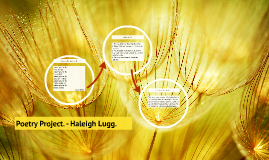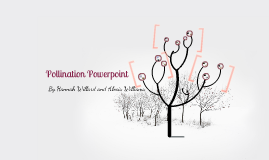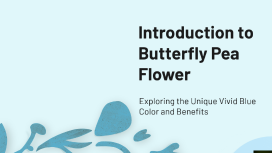Introduction to Butterfly Pea Flower
Transcript: Introduction to Butterfly Pea Flower Flower Structure and Appearance Variations and Species The Butterfly Pea Flower features a distinctive structure with five petals: one large upper petal, two side petals, and two smaller lower petals. This unique formation not only contributes to its beauty but also helps in attracting specific pollinators, including bees. While the most common species is Clitoria ternatea, several variations exist, including those with white and purple petals. Each variation retains the characteristic color-changing properties of the flower, which can shift hues when mixed with different pH solutions, showcasing its adaptability. Vivid Deep Blue Color Exploring the Unique Vivid Blue Color and Benefits The vivid deep blue color of the Butterfly Pea Flower is due to the presence of anthocyanins, which are water-soluble pigments. This striking hue not only attracts pollinators but also plays a crucial role in culinary applications, where it serves as a natural coloring agent for beverages and dishes. Unique Characteristics The Butterfly Pea Flower is renowned for its striking vivid blue color and unique features that set it apart from other flowers. Understanding these characteristics reveals both its aesthetic and practical significance in various applications. Growing Conditions Butterfly pea flower prefers warm temperatures between 20-35°C and benefits from full sun exposure. Well-drained, nutrient-rich soil enhances growth, while adequate humidity supports flower development. Watering should be consistent, allowing the soil to dry between sessions to prevent root rot. Popular Recipes Featuring Butterfly Pea Culinary Uses of Butterfly Pea Flower Butterfly Pea Flower can elevate various dishes, such as rice, desserts, and cocktails. The flower imparts a vibrant blue hue, making dishes visually appealing while enhancing flavor profiles. Popular recipes include butterfly pea rice and colorful sorbets. Butterfly Pea Flower is not only visually stunning but also versatile in culinary applications, transforming dishes and beverages with its vibrant blue color and unique properties. Colorful Food and Beverage Applications Cultivation and Care of Butterfly Pea Flower The butterfly pea flower thrives in tropical climates, requiring well-drained soil, adequate sunlight, and regular watering to flourish. Understanding its growth conditions and care is essential for successful cultivation. With its unique color, butterfly pea flower is a popular ingredient in various food and beverages, including lattes, cocktails, and desserts. The flower’s natural colorant can replace artificial dyes, appealing to health-conscious consumers and enhancing culinary creativity. Maintenance and Harvesting Regular pruning encourages bushier growth and more blooms. Harvest flowers early in the morning, when they're freshly opened, to ensure the best color and aroma. Flowers can be harvested continuously throughout the growing season, promoting new growth. Brewing Butterfly Pea Tea Brewing butterfly pea tea involves steeping dried flowers in hot water, resulting in a striking blue beverage. The tea has a mild earthy flavor and can be enjoyed hot or iced. Adding citrus juice can change its color to purple, offering both aesthetic and taste benefits. Pests and Disease Management Common pests include aphids and spider mites, which can be managed with neem oil or insecticidal soap. Diseases like root rot may occur in poorly drained soil, so it's crucial to monitor soil moisture and ensure proper drainage to prevent issues. Effects on Health and Wellness Butterfly Pea Flower has been linked to various health benefits, including improved cognitive function and reduced inflammation. Regular consumption may contribute to better skin health and digestive support. Nutritional Benefits of Butterfly Pea Flower Overview of the Butterfly Pea Flower Introduction to Butterfly Pea Flower Butterfly Pea Flower is not only visually stunning but also packed with essential vitamins, minerals, and antioxidant properties that promote health and wellness. Its unique compounds offer a multitude of health benefits that have been treasured in traditional medicine. The Butterfly Pea Flower, or Clitoria ternatea, is native to tropical Asia. Renowned for its striking, deep blue petals, this flower is not only attractive but also valued for its various health benefits and uses in food and beverages. The Butterfly Pea Flower, known for its vibrant blue color, is not only visually striking but also holds significant value in various cultural practices and traditional medicine. This presentation section delves into the flower's unique characteristics, its medicinal significance, and its historical relevance. Historical Uses and Cultural Importance Antioxidant Properties Significance in Traditional Medicine Vitamins and Minerals Historically, the Butterfly Pea Flower has been used in Southeast Asian cuisines and rituals. It has played a vital role in

















